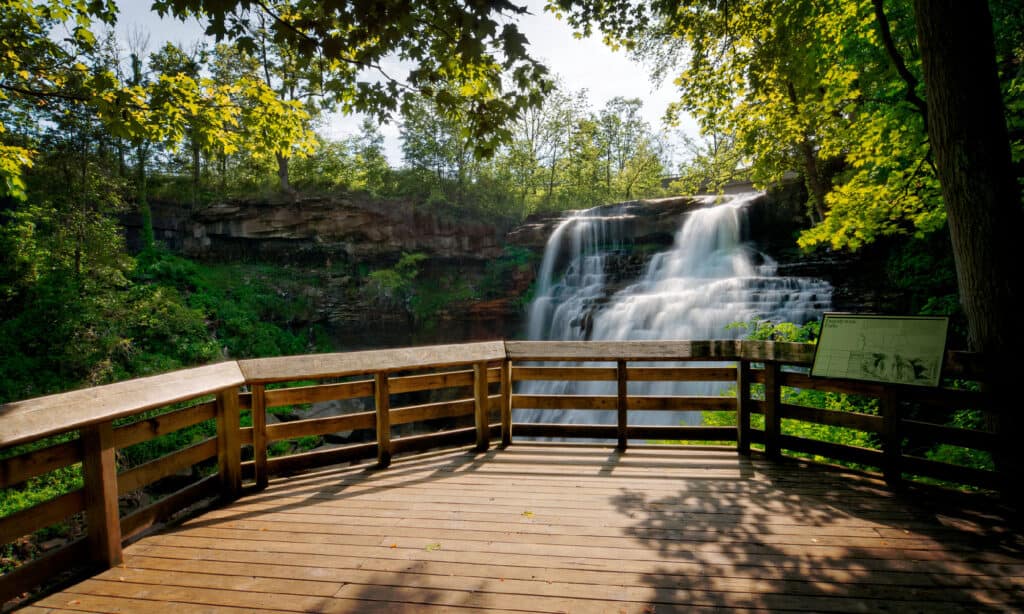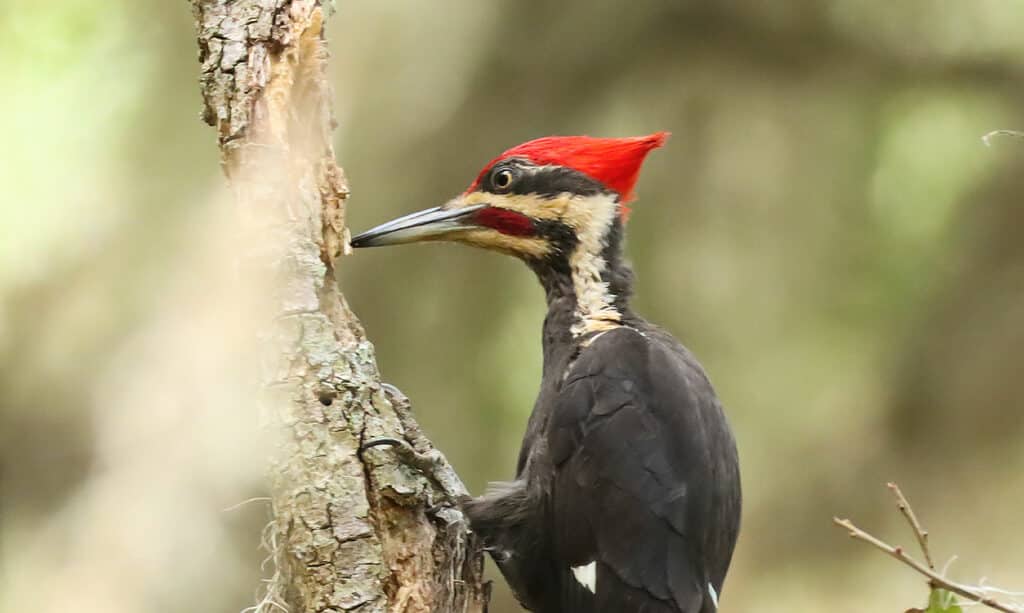Are you looking for the perfect spot for a quick getaway in Ohio? If so, then you’re in luck!
Ohio is home to many beautiful natural wonders, but none are quite as impressive as the tallest waterfall in the state. Located in the Cuyahoga Valley National Park, Brandywine Falls stands 65 feet tall.
It’s an incredible sight to see. This serene waterfall is a stunning natural marvel, with a long stretch of cascading water.
Whether you’re an experienced explorer or simply seeking outdoor beauty, this natural wonder will certainly captivate your imagination. A visit to this waterfall can provide unrivaled peace and tranquility. These majestic falls nestled away in northeast Ohio are a wonderful opportunity for an outdoor escape!
Learn more about the tallest waterfall in Ohio, including how you can visit, what animals you can find there, and what activities are available!
Brandywine Falls – The Tallest Waterfall in Ohio

In Cuyahoga Valley National Park, visitors can admire the stunning Brandywine Falls from an overlook.
©iStock.com/Mshake
Ohio is home to many beautiful waterfalls, but none compare to the spectacular beauty of the tallest waterfall in the state – Brandywine Falls. This natural wonder is located in Cuyahoga Valley National Park, just a short drive from Cleveland. At 65 feet tall, Brandywine Falls is truly a sight to behold.
Visitors can admire the stunning scenery from an overlook or hike to the bottom for a closer look. The park also features a variety of trails that visitors can explore, either on foot, by bike, or on horseback!
History
Brandywine Falls has been an important part of Ohio’s history since a surveyor first discovered it in 1812. The waterfall has been a popular spot for sightseeing ever since. It was even used to power mills during the 1800s. It is now protected as part of Cuyahoga Valley National Park, established in 2000.
Where is Brandywine Falls Located on a Map?
The Stanford Trail is a 1-hour-and-15-minute moderate hike that leads to spectacular boardwalks at the base of the falls. The entire journey is 1.75 miles long. However, the boardwalks are also easily accessible via Brandywine Road. They offer a great view of the falls without the trek!
Short boardwalk trails are ideal if you want to bask in the beauty of nature without working up a sweat. Alternatively, a stairless boardwalk option is available for your convenience.
If you’re craving more adventure, embark on a 1.5-mile journey along Brandywine Gorge Trail and discover the lovely creek!
Uniqueness
Brandywine Falls’s natural amphitheater shape gives it an impressive presence and allows visitors to take in views from multiple angles.
It is also a plunge waterfall, meaning the water cascades over the top in one single drop. The powerful flow of the waterfall can be heard from far away and provides a tranquil atmosphere for visitors.
Planning a Visit to the Tallest Waterfall in Ohio
Best Time to Visit
Visiting the majestic Brandywine Falls is best during spring and early summer. During this time, its near-magical powers are at their apex due to the snowmelt from nearby mountains. After a hearty downpour, the falls are at their peak of beauty and power. However, this waterfall remains magnificently forceful throughout all season, so there’s no wrong season to go.
Summertime can be hot, so it’s best to plan a visit in the morning or evening. It’s also important to ensure the trail is open and check any safety advisories before heading out.
Safety Considerations
It’s important to take precautions when visiting Brandywine Falls. Even a small slip can lead to serious injury due to the waterfall’s power. Visitors should wear appropriate shoes for hiking and make sure to stay on the trail. Also, keep an eye out for slippery rocks and uneven terrain that could cause you to fall.
Activities at Brandywine Falls
In addition to hiking to the falls, visitors can explore other trails in Cuyahoga Valley National Park. There are also plenty of activities to enjoy in the area, such as birdwatching, kayaking, and winter sports.
Visitors can also take advantage of the park’s educational programs and learn more about the natural environment. This beautiful area will leave a lasting impression on any nature lovers.
Wildlife Around Brandywine Falls

Visitors may also see songbirds such as robins, blue jays, cardinals, and woodpeckers!
©iStock.com/Wirestock
At Brandywine Falls, visitors can expect to spot a variety of wildlife. Common sightings include white-tailed deer, turkeys, beavers, and black bears. Visitors may also see songbirds such as robins, blue jays, cardinals, and woodpeckers.
The area is also home to various fish species, such as trout, bass, and catfish. In addition, the waters of Brandywine Falls provide a perfect habitat for aquatic insects like dragonflies and damselflies.
Let’s further explore what animals you can expect to see around Brandywine Falls!
Birds
With its unique and varied topography, Cuyahoga Valley National Park is the perfect home for many bird species. Around 250 bird species call this area home! Unfortunately, 28 of these are critically endangered.
Home to 10 raptors (also known as birds of prey), the Cuyahoga Valley is a haven for summer and year-round bird residents alike. Since 2006, bald eagles have been nesting in this picturesque valley and can often be seen soaring overhead. Likewise, if you’re lucky enough, you may spot graceful peregrine falcons high above the lush terrain.
The park’s array of aquatic habitats is a haven for an abundance of birds, some new to the area! For example, the great blue heron’s presence was virtually unheard of in the 1980s. Now, three nesting sites can be found within or near the valley’s boundaries. Furthermore, wood ducks, Canadian geese, and other types of waterfowl have made this nature reserve their home.
Mammals

A great many bats call this area home. An impressive nine species of bats were discovered in the park during a 2002 survey.
©Bernd Wolter/Shutterstock.com
The lush Cuyahoga Valley National Park is home to an incredible 41 mammal species, offering sanctuary for many awesome creatures.
After a prolonged absence, coyotes eventually returned to the valley in the 1980s. They now reign as dominant predators in the park ecosystem. The large forest edge habitat comprising sprawling meadows and fields provides these canines with plenty of sustenance.
Cuyahoga Valley is also home to many small mammals, such as mice, moles, voles, shrews, chipmunks, and squirrels. You can find these animals across the park’s lush forests, open fields, and expansive wetlands.
If you’re a fan of flying mammals, you’ll be excited that a great many bats call this area home too. An impressive nine species of bats were discovered in the park during a 2002 survey, three of which hadn’t been seen before.
Come morning or night, you will likely encounter white-tailed deer and woodchucks nibbling on roadside vegetation along open fields. If you’re lucky, you may even spot the nimble raccoons or opossums racing across the road in search of sustenance or a place to hide before dawn.
Reptiles
While visiting the Cuyahoga Valley, keep an eye out for its abundance of wetlands, ponds, and lakes. On a warm day, you might catch a northern water snake basking in the sun or spot the curious gaze of a common snapping turtle peeking through patches of duckweed.
No deadly snakes have been sighted in the national park. However, the endangered eastern massasauga and northern copperhead have been discovered outside of it, so it’s possible that they may eventually wander into the area.
In Ohio, certain turtles are protected and have special conservation status. Among them is the spotted turtle, classified as “threatened” and found in the area in 2008. Furthermore, both eastern box turtles and blanding turtles fall under Species of Special Interest within this area.
Amphibians
Amphibians contribute to the delicate equilibrium of ecosystems. Due to their abdominal skin’s ability to simultaneously absorb water and air, they act as incredibly efficient indicators of environmental health. Unfortunately, this can also make them extremely susceptible to localized sources of contamination.
Take a tranquil stroll along the Towpath Trail during a late spring morning. Your ears will be graced with the joyous “peep-peep-peep” of enthusiastic spring peepers. Or perhaps you’ll hear the deep reverberating “rumm-rumm-rumm” emanating from an inquisitive bullfrog.
Witnessing the seasonal salamander migration on a drizzly spring night is impressive. The amphibians can be difficult to locate, typically taking shelter in the woodlands close to impermanent ponds or streams. If you’re lucky enough, you might catch a glimpse of these fascinating creatures during your journey through the park!
Final Thoughts
Ohio’s Cuyahoga Valley National Park is a tranquil oasis of nature. Its diverse array of flora and fauna contributes to the natural equilibrium of this beautiful landscape.
The tallest waterfall in Ohio adds to the scenery. Deep within this reserve, its thunderous cascades offer a sense of awe to passersby.
With a plethora of wildlife to observe, from majestic birds of prey to secretive small mammals, this national park is perfect for the animal obsessed. It’s a great destination for anyone looking to take a break from their daily lives and immerse themselves in nature.
Whether you’re an outdoor enthusiast or simply looking for a peaceful escape from everyday life, this gorgeous area is worth exploring. Discover your own piece of paradise in the Cuyahoga Valley National Park, and take in the beauty of one of Ohio’s most incredible natural wonders.
The photo featured at the top of this post is © iStock.com/ehrlif
Thank you for reading! Have some feedback for us? Contact the AZ Animals editorial team.






